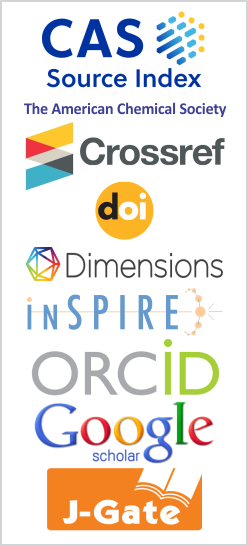Study of the Effect of Artificial Gauge Field on the Supersolid Phase in Cold Atomic Condensates
DOI:
https://doi.org/10.26713/jamcnp.v1i1.203Keywords:
Artificial gauge filed, Ultra cold atoms, SupersolidAbstract
Ultra cold atomic condensate with long range interaction is considered as a possible candidate to realize the supersolid phase. Such a supersolid phase can be subjected to artificial gauge field created either through rotation or by introducing space dependent coupling among hyperfine states of the atoms using Raman lasers. We study the effect of an artificial gauge field on the Supersolid phase in ultracold atomic condensates with long range interactions. Using Mean field approach, we demonstrate the structural differences between vortex in a supersolid and superfluid. We determine analytically the effect of the artificial gauge field on the density wave - supersolid (DW-SS) and the Mott insulator-superfluid (MI-SF) transition boundary. We also point out that in symmetric gauge the momentum distribution structure at these transition boundaries bears distinctive signatures of vortices in supersolid and superfluid phases. We point out that these results can clearly identify such a ultra cold atomic supersolid phase.Downloads
References
T. Lahaye et al., Nature (London) 448, 672 (2007).
N. Henkel, R. Nath and T. Pohl, Phys. Rev. Lett. 104, 195302 (2010).
K.-K. Ni et al., Science 322, 231 (2008).
D. Jaksch et al., Phys. Rev. Lett. 81, 3108 (1998);
K. Sheshadri et al., Europhys. Lett. 22, 257 (1993).
D. L. Kovrizhin, G. V. Pai and S. Sinha, Europhys. Lett. 72, 162 (2005).
E. Kim and M. H. W. Chan, Sciencs 305, 1941 (2004).
J. D. Reppy, Phys. Rev. Lett. 104 255301 (2010);
N. Prokofév, Adv. Phys. 56, 381 (2007);
P. W. Anderson, W. F. Brinkman and D. A. Huse, Science 310, 1164 (2005).
K. W. Madison, F. Chevy, W. Wohlleben and J. Dalibard, Phys. Rev. Lett. 84, 806 (2000);
S. Tung, V. Schweikhard and E. A. Cornell, Phys. Rev. Lett. 97, 240402 (2006);
R. A. Williams, S. Al Assam and C. J. Foot, ibid. 104, 050404 (2010).
Y.-J. Lin et al., Nature 462, 628 (2009).
R. Sachdeva, S. Johri and S. Ghosh, Phys. Rev. A 82, 063617 (2010).
R. Sachdeva and S. Ghosh, Phys. Rev. A 85, 013642 (2012).
M. Greiner et al., Nature 415, 39, (2002);
J. E. Simsarian et al., Phys. Rev. Lett. 85, 2040 (2000).
S. R. Muniz et al., Phys. Rev. A 73, 041605(R) (2006).
J. K. Freericks and H. Monien, Phys. Rev. B 53, 2691 (1996).
J. K. Freericks and H. Monien, Europhys. Lett. 26, 545 (1994).
W. Krauth, N. Trivedi and D. Ceperley, Phys. Rev. Lett. 67, 2307 (1991).
Downloads
How to Cite
Issue
Section
License
Authors who publish with this journal agree to the following terms:- Authors retain copyright and grant the journal right of first publication with the work simultaneously licensed under a CCAL that allows others to share the work with an acknowledgement of the work's authorship and initial publication in this journal.
- Authors are able to enter into separate, additional contractual arrangements for the non-exclusive distribution of the journal's published version of the work (e.g., post it to an institutional repository or publish it in a book), with an acknowledgement of its initial publication in this journal.
- Authors are permitted and encouraged to post their work online (e.g., in institutional repositories or on their website) prior to and during the submission process, as it can lead to productive exchanges, as well as earlier and greater citation of published work.




